Introduction
This tutorial shows you how to implement a Groovy script that validates data entry against allowed ranges stored in a driver cube.
Background
In this example, you'll create a script that runs when users save updates to employee salaries and bonuses from a data entry form. The script loads employee grade data (minimum/maximum allowed salary and minimum/maximum allowed bonus) from a driver cube into a temporary grid in memory, and then validates the entered salary and bonus values against the allowed ranges.
Prerequisites
Cloud EPM Hands-on Tutorials may require you to import a snapshot into your Cloud EPM Enterprise Service instance. Before you can import a tutorial snapshot, you must request another Cloud EPM Enterprise Service instance or remove your current application and business process. The tutorial snapshot will not import over your existing application or business process, nor will it automatically replace or restore the application or business process you are currently working with.
Before starting this tutorial, you must:
- Have Service Administrator access to a Cloud EPM Enterprise Service instance.
- Upload and import this snapshot into your Planning instance. If you've previously uploaded the snapshot for another Groovy tutorial, you can continue using the same snapshot.
Note:
If you run into migration errors importing the snapshot, re-run the migration excluding the HSS-Shared Services component, as well as the Security and User Preferences artifacts in the Core component. For more information on uploading and importing snapshots, refer to the Administering Migration for Oracle Enterprise Performance Management Cloud documentation.Tip:
The scripts you need for this tutorial are linked as text files within each section.Creating the script
- Open Calculation Manager and create a rule named Groovy Validate Employee Data in the Plan1 cube.
- In the Rule Editor, change the Designer option to Edit Script and set the Script Type to Groovy Script.
- Copy this script and paste it into the editor.
- On the toolbar, click
(Save) to save the script, then click
(Validate and Deploy) to validate and deploy the script. Click OK when prompted. Close Calculation Manager.
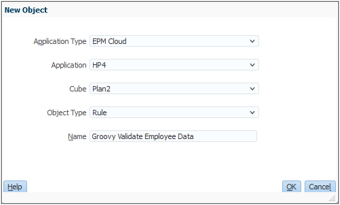
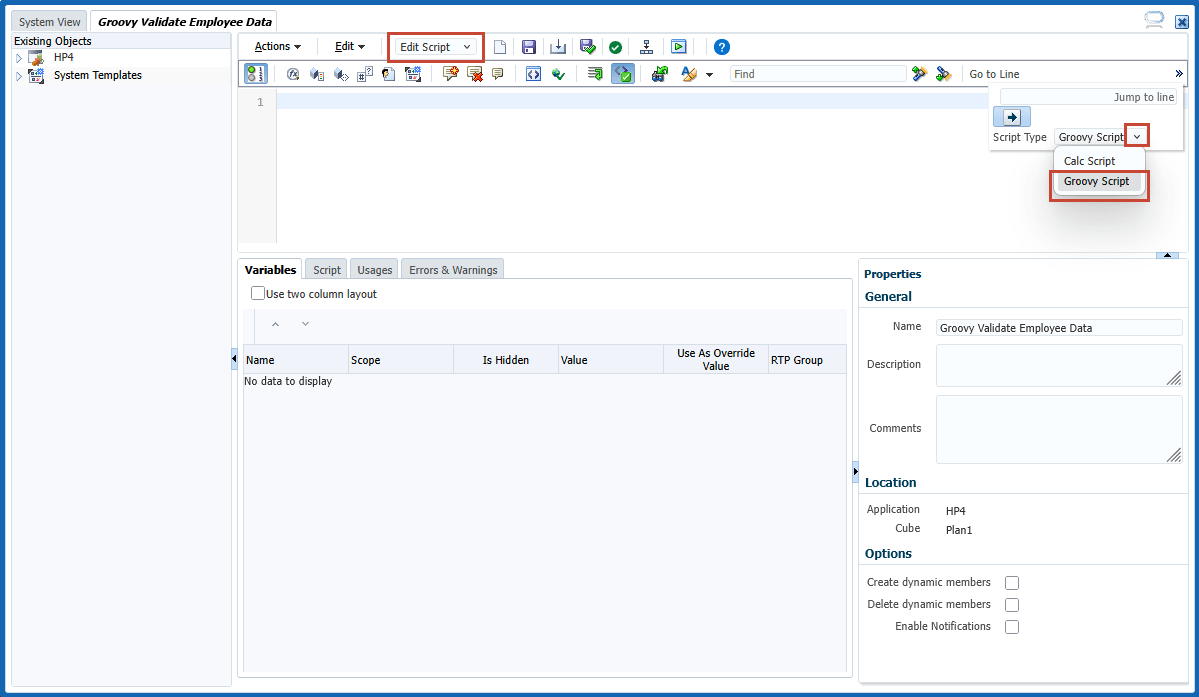
class GradeData {
Integer Grade
DataGrid.DataCell minSalary
DataGrid.DataCell maxSalary
DataGrid.DataCell minBonus
DataGrid.DataCell maxBonus
public String toString() {
return "minSalary: ${minSalary?.formattedValue}, maxSalary: ${maxSalary?.formattedValue}, minBonus: ${minBonus?.formattedValue}, maxBonus: ${maxBonus?.formattedValue}"
}
}
// Create a resource bundle loader containing localized messages needed by this rule.
def mbUs = messageBundle( ["validation.missingmember.grade":"No Grades found on the Grid."] )
def mbl = messageBundleLoader(["en" : mbUs])
Cube lookupCube = operation.application.getCube("Plan1")
DataGridDefinitionBuilder builder = lookupCube.dataGridDefinitionBuilder()
builder.addPov(['Years', 'Scenario', 'Currency', 'Period', 'Version', 'Entity'], [['FY16'], ['Current'], ['USD'], ['BegBalance'],
['BU Version_1'], ['No Entity']])
builder.addColumn(['Account'], [ ['Min Salary', 'Max Salary', 'Min Bonus', 'Max Bonus'] ])
builder.addRow(['Grades'], [ ['ILvl0Descendants("Grades")'] ])
DataGridDefinition gridDefinition = builder.build()
// Load the data grid from the lookup cube
DataGrid dataGrid = lookupCube.loadGrid(gridDefinition, false)
// Create a map of grade data (Min/Max Salary and Bonus) by grade name from the data grid.
def gradeDataMap = new HashMap()
if(dataGrid) {
println("dataGrid is not null")
dataGrid.dataCellIterator('Min Salary').each {
def gradeData = new GradeData()
gradeData.minSalary = it
gradeData.maxSalary = it.crossDimCell('Max Salary')
gradeData.minBonus = it.crossDimCell('Min Bonus')
gradeData.maxBonus = it.crossDimCell('Max Bonus')
gradeDataMap[(it.getMemberName('Grades'))] = gradeData
println(it.getMemberName('Grades') + ": " + gradeData)
}
}
DataGrid grid = operation.grid
// Construct an iterator that iterates over all data cells containing the Grade member.
GridIterator itr = grid.dataCellIterator('Grade')
// Throw a veto exception if the grid has at least one cell but does not contain any cells containing the Grade member.
if(!grid.empty && !itr.hasNext()) {
// Found 0 cells with Grade
throwVetoException(mbl, "validation.missingmember.grade")
}
// Validate the values in the grid being saved against the values in gradeDataMap.
itr.each {
GradeData gradeData = gradeDataMap[it.DataAsSmartListMemberName]
if(gradeData == null) {
println("Unable to locate grade data for grade: ${it.DataAsSmartListMemberName}, with data value: ${it.formattedValue}" )
} else {
println(it.getMemberName('Employee') + ": " + gradeData.toString())
DataCell salary = it.crossDimCell('Salary')
if(salary == null)
println("Unable to locate Salary")
else if(salary.data < gradeData.minSalary.data || salary.data > gradeData.maxSalary.data) {
salary.addValidationError(0xFF0000, "Salary is outside of the allowed range.")
}
DataCell bonus = it.crossDimCell('Bonus')
if(bonus == null) {
println("Unable to locate Bonus")
} else if(bonus.data < gradeData.minBonus.data || bonus.data > gradeData.maxBonus.data) {
bonus.addValidationError(0xFF0000, "Bonus is outside of the allowed range.")
}
}
}
Explaining the script logic
In this section, we'll describe the script logic one section at a time.
-
Create a class.
class GradeData { Integer Grade
DataGrid.DataCell minSalary
DataGrid.DataCell maxSalary
DataGrid.DataCell minBonus
DataGrid.DataCell maxBonus
public String toString() {
return "minSalary: ${minSalary?.formattedValue},
maxSalary: ${maxSalary?.formattedValue},
minBonus: ${minBonus?.formattedValue},
maxBonus: ${maxBonus?.formattedValue}"
Integer Grade
DataGrid.DataCell minSalary
DataGrid.DataCell maxSalary
DataGrid.DataCell minBonus
DataGrid.DataCell maxBonus
public String toString() {
return "minSalary: ${minSalary?.formattedValue},
maxSalary: ${maxSalary?.formattedValue},
minBonus: ${minBonus?.formattedValue},
maxBonus: ${maxBonus?.formattedValue}"  }
}
}
} Create a class,
Create a class, GradeData, to store the employee grade data (minimum/maximum allowed salary and minimum/maximum allowed bonus) from a driver cube. The
The toString()method returns a string representation of theGradeDataobject. The method uses the null safe operator (?.) provided by Groovy. If the variable before the question mark is null it will not proceed and returnsNULL. For example,{minSalary?.formattedValue}evaluates toNULLvalue instead of throwing aNullPointerExceptionexception ifminSalaryis null. - Create a bundle loader.
- Load the data grid from the lookup cube for the region defined by the DataGridDefinition object.
- Create a map of grade data (Min/Max Salary and Bonus) by grade name from the data grid.
def gradeDataMap = new HashMap<String, GradeData>()
 if(dataGrid) {
println("dataGrid is not null")
dataGrid.dataCellIterator('Min Salary').each {
if(dataGrid) {
println("dataGrid is not null")
dataGrid.dataCellIterator('Min Salary').each {  def gradeData = new GradeData()
gradeData.minSalary = it
gradeData.maxSalary = it.crossDimCell('Max Salary')
gradeData.minBonus = it.crossDimCell('Min Bonus')
gradeData.maxBonus = it.crossDimCell('Max Bonus')
gradeDataMap[(it.getMemberName('Grades'))] = gradeData
println(it.getMemberName('Grades') + ": " + gradeData)
}
}
def gradeData = new GradeData()
gradeData.minSalary = it
gradeData.maxSalary = it.crossDimCell('Max Salary')
gradeData.minBonus = it.crossDimCell('Min Bonus')
gradeData.maxBonus = it.crossDimCell('Max Bonus')
gradeDataMap[(it.getMemberName('Grades'))] = gradeData
println(it.getMemberName('Grades') + ": " + gradeData)
}
} Create a map called
Create a map called gradeDataMapof grade data (Min/Max Salary and Bonus) by grade name. Populate the
Populate the gradeDataMapmap with the grade data for each Grade. Grade is the key and the GradeData object populated with the Min/Max Salary and Bonus is the value. - Construct an iterator that iterates over all data cells containing the Grade member in the current input grid.
- Throw a veto exception.
- Validate the grid values.
// Create a resource bundle loader containing localized messages needed by this rule. def mbUs = messageBundle( ["validation.missingmember.grade":"No Grades found on the Grid."] )def mbl = messageBundleLoader(["en" : mbUs]) Cube lookupCube = operation.application.getCube("Plan1")
DataGridDefinitionBuilder builder = lookupCube.dataGridDefinitionBuilder()
builder.addPov(['Years', 'Scenario', 'Currency', 'Period', 'Version', 'Entity'], [['FY16'], ['Current'], ['USD'], ['BegBalance'], ['BU Version_1'], ['No Entity']]) builder.addColumn(['Account'], [ ['Min Salary', 'Max Salary', 'Min Bonus', 'Max Bonus'] ]) builder.addRow(['Grades'], [ ['ILvl0Descendants("Grades")'] ]) DataGridDefinition gridDefinition = builder.build()

 Create a resource bundle loader containing localized messages needed by this rule.
Create a resource bundle loader containing localized messages needed by this rule.
 Get the driver/lookup cube.
Get the driver/lookup cube.
 Get a DataGridDefinitionBuilder for the cube. Use the builder to construct a region from which to load the data by adding the POV members, column members and rows.
Get a DataGridDefinitionBuilder for the cube. Use the builder to construct a region from which to load the data by adding the POV members, column members and rows.
 Build the DataGridDefinition object.
Build the DataGridDefinition object.
DataGrid dataGrid = lookupCube.loadGrid(gridDefinition, false)
DataGrid grid = operation.grid
GridIterator itr = grid.dataCellIterator('Grade')
// Throw a veto exception if the grid has at least one cell but does not contain any cells containing the Grade member.
if(!grid.empty && !itr.hasNext()) {  // Found 0 cells with Grade
throwVetoException(mbl, "validation.missingmember.grade")
}
// Found 0 cells with Grade
throwVetoException(mbl, "validation.missingmember.grade")
}
 Validate that the input grid has at least one cell containing the Grade member. If not, throw a veto exception with the localized message.
Validate that the input grid has at least one cell containing the Grade member. If not, throw a veto exception with the localized message.
// Validate the values in the grid being saved against the values in gradeDataMap.
itr.each {  GradeData gradeData = gradeDataMap[it.DataAsSmartListMemberName]
if(gradeData == null) {
println("Unable to locate grade data for grade: ${it.DataAsSmartListMemberName},
with data value: ${it.formattedValue}" )
} else {
println(it.getMemberName('Employee') + ": " + gradeData.toString())
DataCell salary = it.crossDimCell('Salary')
GradeData gradeData = gradeDataMap[it.DataAsSmartListMemberName]
if(gradeData == null) {
println("Unable to locate grade data for grade: ${it.DataAsSmartListMemberName},
with data value: ${it.formattedValue}" )
} else {
println(it.getMemberName('Employee') + ": " + gradeData.toString())
DataCell salary = it.crossDimCell('Salary')  if(salary == null)
println("Unable to locate Salary")
else if(salary.data < gradeData.minSalary.data || salary.data > gradeData.maxSalary.data)
{
salary.addValidationError(0xFF0000, "Salary is outside of the allowed range.")
}
DataCell bonus = it.crossDimCell('Bonus')
if(salary == null)
println("Unable to locate Salary")
else if(salary.data < gradeData.minSalary.data || salary.data > gradeData.maxSalary.data)
{
salary.addValidationError(0xFF0000, "Salary is outside of the allowed range.")
}
DataCell bonus = it.crossDimCell('Bonus')  if(bonus == null) {
println("Unable to locate Bonus")
} else if(bonus.data < gradeData.minBonus.data || bonus.data > gradeData.maxBonus.data) {
bonus.addValidationError(0xFF0000, "Bonus is outside of the allowed range.")
}
}
}
if(bonus == null) {
println("Unable to locate Bonus")
} else if(bonus.data < gradeData.minBonus.data || bonus.data > gradeData.maxBonus.data) {
bonus.addValidationError(0xFF0000, "Bonus is outside of the allowed range.")
}
}
}
 Validate the values in the input grid being saved against the values in gradeDataMap. Grade in the input grid is an account of type smart list which is derived from the Grade hierarchy defined in the lookup cube. Calling
Validate the values in the input grid being saved against the values in gradeDataMap. Grade in the input grid is an account of type smart list which is derived from the Grade hierarchy defined in the lookup cube. Calling it.DataAsSmartListMemberName gets the name of the member from which the current cell’s smart list value is derived, which can then be used as the key in the map to get the grade data.
 Cross dim into the Salary cell and validate the Salary against the allowed Salary in the grade data.
Cross dim into the Salary cell and validate the Salary against the allowed Salary in the grade data.
 Cross dim into the Bonus cell and validate the Bonus against the allowed Bonus in the grade data.
If the Salary or Bonus is not within the allowed limits, set the background color of the cell to red and add a validation error on the cell by calling the
Cross dim into the Bonus cell and validate the Bonus against the allowed Bonus in the grade data.
If the Salary or Bonus is not within the allowed limits, set the background color of the cell to red and add a validation error on the cell by calling the addValidationError() API. The error message will be set as the tooltip of the cell and will also show up in the Grid Validation Messages. Also, if this rule is being run After Save, the system will veto the save operation.
Testing the script
- In the Form Manager, edit the ManageEmployees form and associate the Groovy Validate Employee Data rule to be run After Load and Before Save (you may need to select Plan1 from the Cube list first).
- Save the form and close the Form Manager window.
- Open the Employees dashboard. Add a Bonus of 1000 for Employee 1, increase the Salary for Employee 2 to 65000. On the form toolbar, click
(Save).
- In the Error message dialog box, click OK.
- Hover the mouse over the red cells to see the detailed error messages as tooltips.


- Close the dashboard and open the Jobs console.
- Click Groovy Validate Employee Data to display the job details. Click the Completed status to see the grade data loaded from the lookup cube and the grade data per each employee's grade.
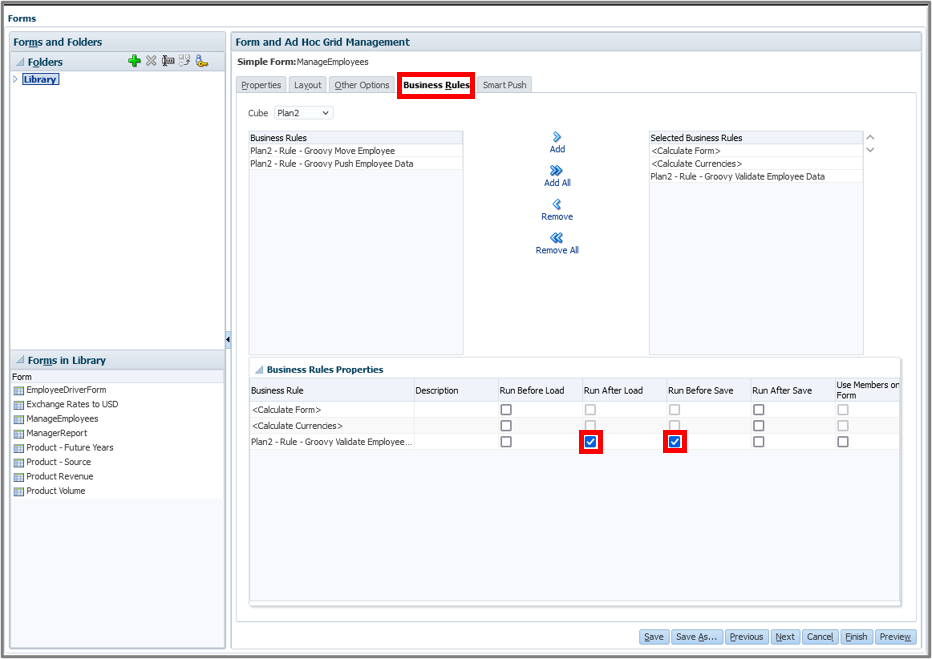
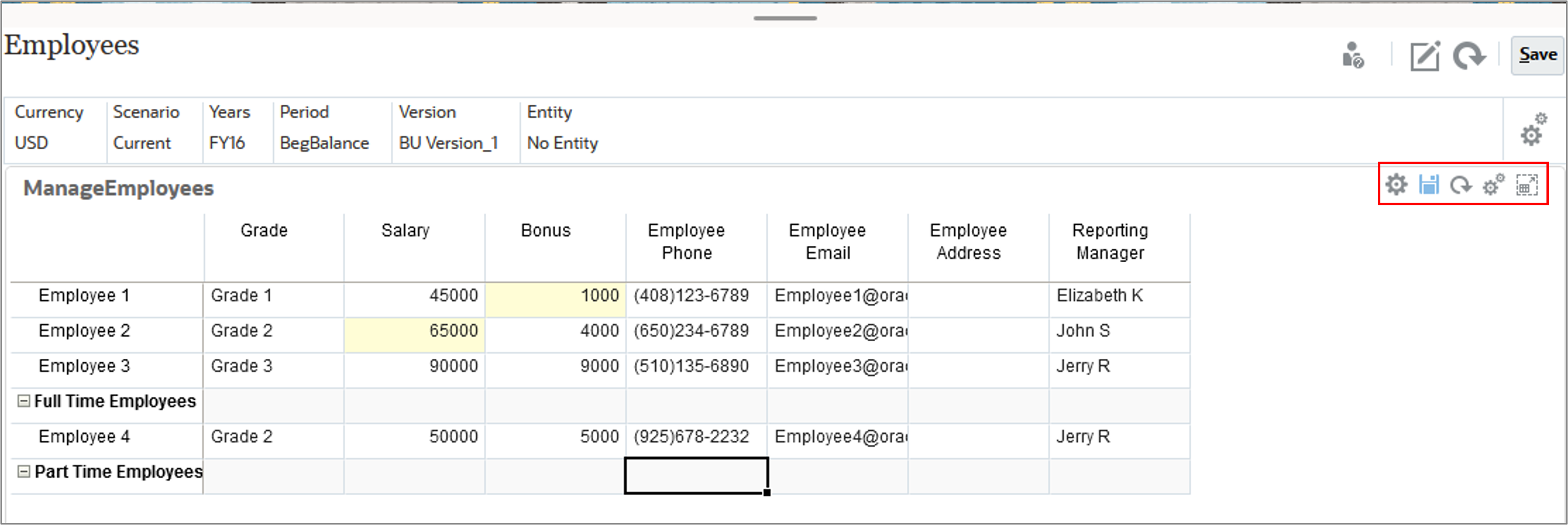
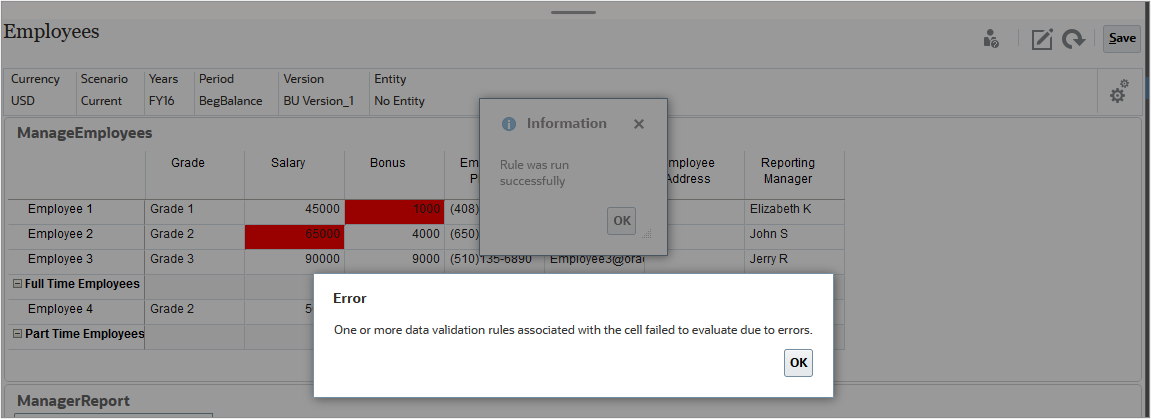
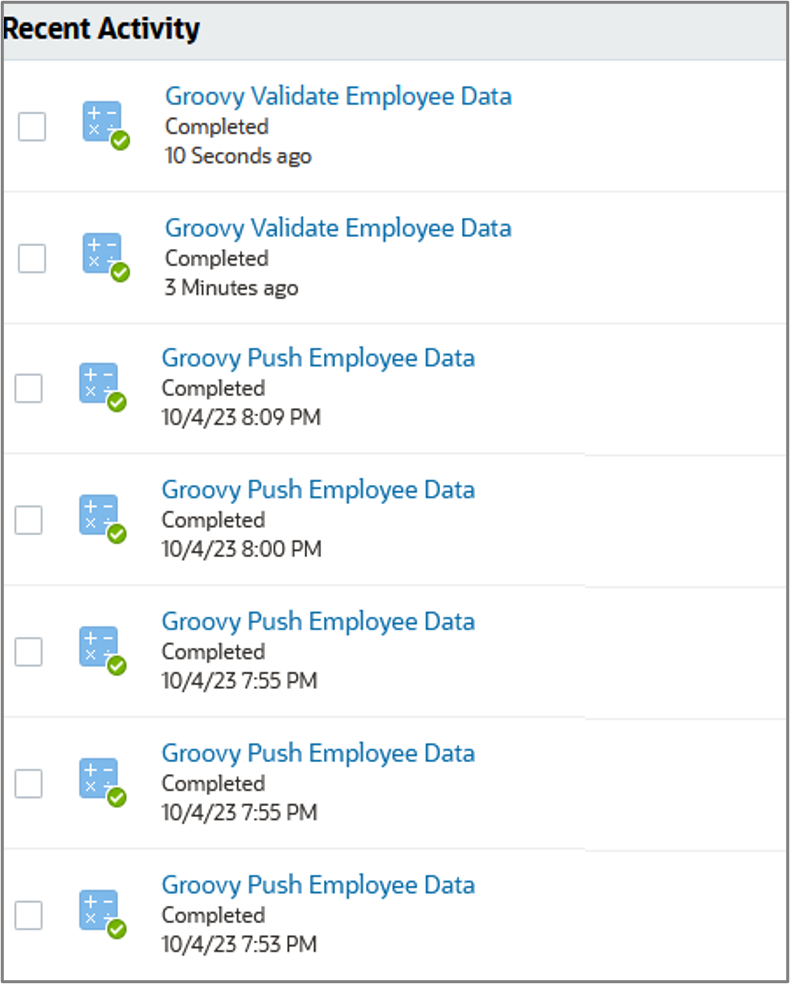

Related Links
More Learning Resources
Explore other labs on docs.oracle.com/learn or access more free learning content on the Oracle Learning YouTube channel. Additionally, visit Oracle University to view training resources available.
For product documentation, visit Oracle Help Center.
Validating Data Entry Values with Groovy
F87589-02
October 2025